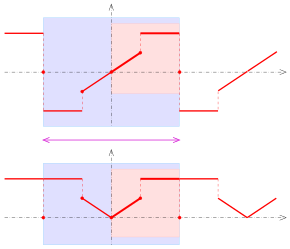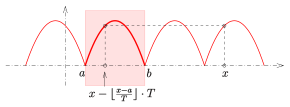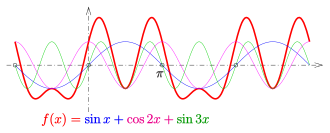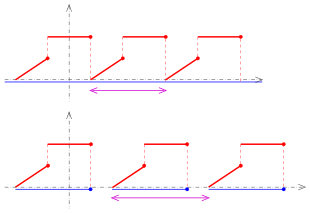Periodic function
![]()
This article deals with the mathematical term period in the meaning of the interval in the regular recurrence of a function value. See Period (decimal fraction) and Period for other meanings of the term.
In mathematics, periodic functions are a special class of functions. They have the property that their function values repeat at regular intervals. The intervals between the occurrence of the same function values are called period. Simple examples are sine and cosine functions. So that functions with gaps in the definition range, such as the tangent function, can also be counted as periodic functions, one allows definition ranges with periodic gaps. However, a periodic function does not have only one period, because each multiple of a period is also a period. Example: The sine function is not only 


Periodic functions occur naturally in physics to describe mechanical, electrical, or acoustic oscillatory processes. Therefore, a period is often denoted by 
Since a periodic function is known if its course within a period is known, non-trigonometric periodic functions are usually defined in a basic interval and then continued periodically.
Just as many real functions can be developed in power series, one can, under certain conditions, develop a periodic function as a series of sine and cosine functions: see Fourier series.
Periodic sequences can be understood as special cases of periodic functions.
Functions that are not periodic are sometimes referred to - for extra emphasis - as aperiodic.

function graph of the tangent function

Function graph of the sine function
Real periodic functions
Definition
A real number 



is in
and
The function 



For 
Properties of the periods
The following properties apply to the period:
- If
a period of
then also
a period of
;
- If
and
two periods of
, then
with
a period of
.
Mostly one is interested in the smallest positive period. This exists for any nonconstant continuous periodic function. (A constant function is periodic with any period other than 0.) If 




Examples
Trigonometric functions
The standard examples of periodic functions are the trigonometric functions. For example, the sine function defined on all of 



The tangent function with domain of definition 




Sum of cos and sin functions
Sums of cos and sin functions with a common (not necessarily smallest) period 


Periodic continuation
In the definition example at the top of the figure, a function given on a half-open interval ![(a,b]](https://www.alegsaonline.com/image/6a6969e731af335df071e247ee7fb331cd1a57ae.svg)

The following formal definition also provides a way to evaluate a periodically continued function with a computer, since the rounding function used is directly or indirectly realized in many mathematics systems.
DefinitionIf
a function 
![[a, b]](https://www.alegsaonline.com/image/9c4b788fc5c637e26ee98b45f89a5c08c85f7935.svg)


the (direct) periodic continuation of 


⌊

Example: periodic continuation of parabolic arc 

Since periodic functions are often developed in Fourier series and an even/odd periodic function can only be represented with cosine/sine terms, the following continuations are of particular interest:
Odd continuation:
In this case, one starts from a function ![{\displaystyle [0,b]}](https://www.alegsaonline.com/image/ba22e25e8f8604f012c599a7d4962562c4bb3f02.svg)
the interval 

The function ![[-b,b]](https://www.alegsaonline.com/image/748f7ef451a55193dffa8c3f65a0eaadce1dfa41.svg)




Just continued:
The analog procedure with
yields an even periodic function of period 
Fourier series: Example
→ Main article: Fourier series
The Fourier series of a 

with
The goal of a Fourier series expansion is to approximate a periodic function on (all of !) 

In the figure, a function ![[0,\pi ]](https://www.alegsaonline.com/image/3e2a912eda6ef1afe46a81b518fe9da64a832751.svg)





In the example
and the partial sum for n=3:

Fourier series: various Partial sums (blue)

Periodic continuation of the function in the pink area: top: odd, bottom: even

Periodic continuation of a parabolic arc

Sum of cos and sin functions
More general definition
The notion of periodic function is not limited to real functions. It can be defined more generally for functions on whose source set an addition is declared.
Let 



for all 


Search within the encyclopedia







![{\displaystyle [-b,0]}](https://www.alegsaonline.com/image/984429077d806db727381b7b81ec6335d0217e48.svg)







